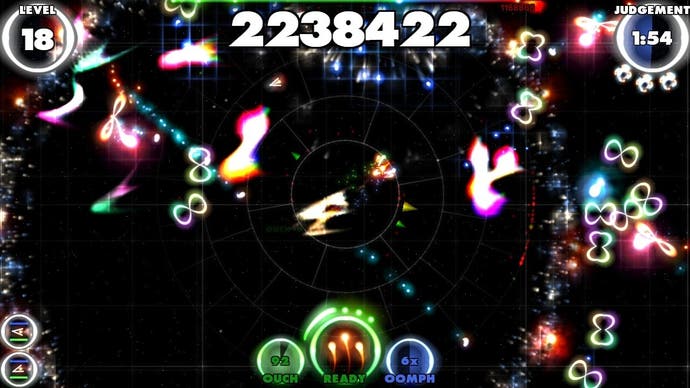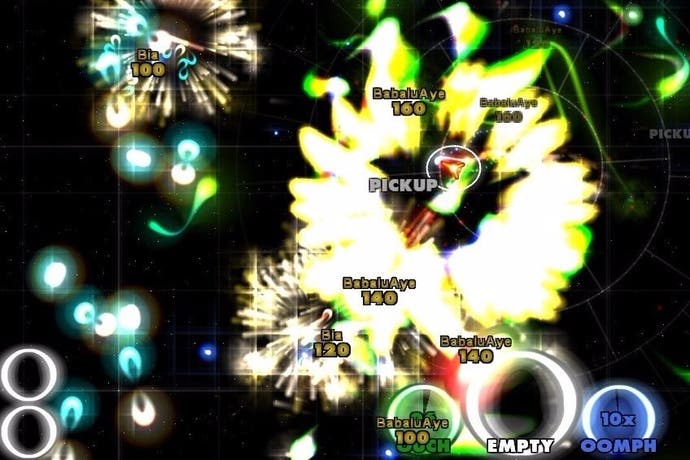Bezier review
Curve balls.
Bezier, despite the French title, lifted from the Renault employee Pierre Bézier, who in the 1960s helped teach computers how to draw curves, is a quintessentially British sort of video game. It fits snugly within the tradition of eccentric psychedelic shooters - Jeff Minter's Space Giraffe, Rob Fearon's Death Ray Manta, Bizarre Creations' Geometry Wars - and combines the unusual bedfellows of austere science fiction storytelling with twin stick shooting. Eight years in the making, the game, intended to be the first in a series of nine projects by its creator, Philip Bak, is a glorious carnival of neon particle effects, subtle tips of the hat to arcade classics and enthralling, if riotous, game design.
Comparisons to Geometry Wars are natural: both games take place over a light-pricked star-scape; both games feature a glowing cast of geometric shapes that are out to kill you with single-minded dedication. As in Geometry Wars, these skittish killers swarm in your wake as you sweep the square play area, then scatter as soon as you pivot your guns their way. And both games are best played with a loose grip, in a Zen-like state where the visual noise and frippery peels away, allowing you to dodge and plot with clarity.

While Geometry Wars found beauty and complexity through a narrow set of mathematical rules, Bezier comes with a thatch of systems. There's a lot to juggle in the three or so minutes you have to complete each of the game's 15-odd stages, but, once properly understood, the magnificence in the blend becomes immediately obvious. Your ship's health (known, cutely, as 'Ouch') depletes each time you're struck by a bullet or a rival hull. This can be replenished by collecting the tiny green fragments dropped by downed foes, or by shooting down one of the few health restoring asteroids scattered about each stage. Blue fragments, by contrast, increase your gun's power (and score multiplier) up to ten times its basic kick. This multiplier is constantly depleting, so, in order to maximise your chances as both survival and high score, you must keep sucking up a steady stream of fragments.
Each stage features four or five 'shields', glowing bullet-sponges, all of which must be destroyed before the timer runs out, else an immediate 'game over' is triggered. At first, each shield is destroyed simply by shooting at it for a while but, as the game progresses, you must first destroy their defences before the core becomes vulnerable. You are entirely responsible for how you manage your time in a stage. It's easy to become distracted with grunts and fail to take down the shields in a timely manner, leaving the game to issue crimson warnings of your impending doom during the final 30 seconds of a stage.
Time management is further complicated by the fact that the shields appear in the field sporadically. You must keep a constant eye on the elegant radar, which is overlaid in the centre of your screen, in order to see where the next shield has popped up. In the final seconds of a stage a new and powerful enemy, Magus Domus, appears. Like Spelunky's ghost, Domus cannot be destroyed, so, in the moments when you're at your most frantic, trying to finish up your remaining tasks before the clock runs out, you're simultaneously forced to flee an all-powerful space mage, whose quips ("My mother hits me harder than that.") will add insult to any injury he manages to inflict.

As with all the strongest shoot 'em ups, Bezier is a game played on two mental planes. There's the elemental, shoot-them-before-they-shoot-you aspect, in which you make a thousand micro fight/ flight decisions, dodging incoming enemies as they blaze back and forth with lunges, feints and retreats. This is Bezier as a straightforward shooter, in which you're trying to clear the field of targets before the timer runs out, ensuring that you keep your health level topped up at all times.
Then there's the plane in which you're paying attention to your score, as it tickertapes upward. This is the part of the strategy that sends you hoovering after every grain-throw of Oomph, the part of you that doesn't rush to eliminate the shields in the quickest possible time, but instead opts to take the scenic route, wringing every possible point from the field before progressing.
Bak completes the picture with a surprisingly engaging story, told in sentence long spoken fragments of exposition at the beginning of each stage. Inside this computer realm, into which humans have retreated and have been corrupted, you find unusually grandiose themes for a type of game that's typically uninterested in anything beyond the primary thrill of blasting clusters of light into smaller fragments. Geometry Wars is a game of straightforward lines. Bezier, as its name suggests, is a game about curves and curveballs, from its arcane storyline, to its tangle of unusual systems. It doesn't take long for the beauty and artistry to rise from what, at first glance, seems like mere chaos.


